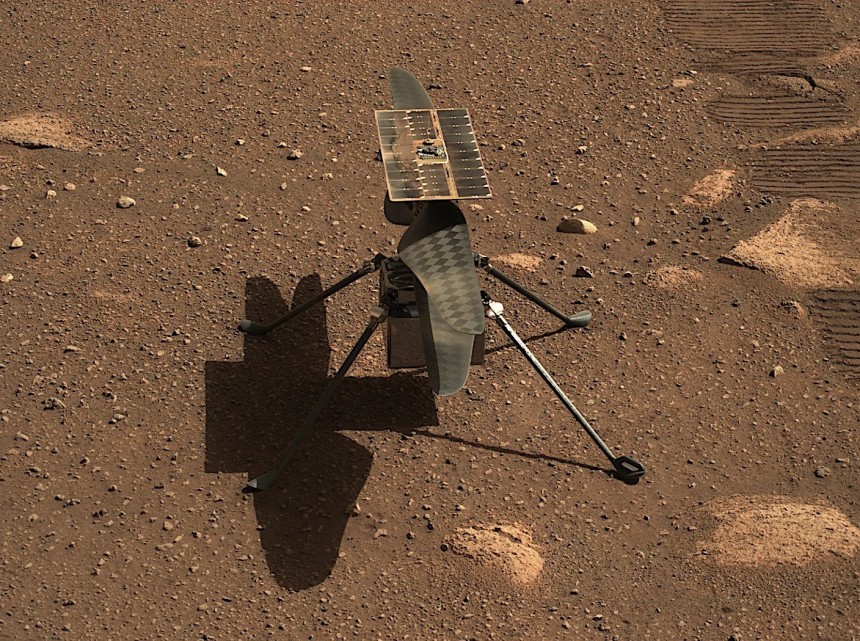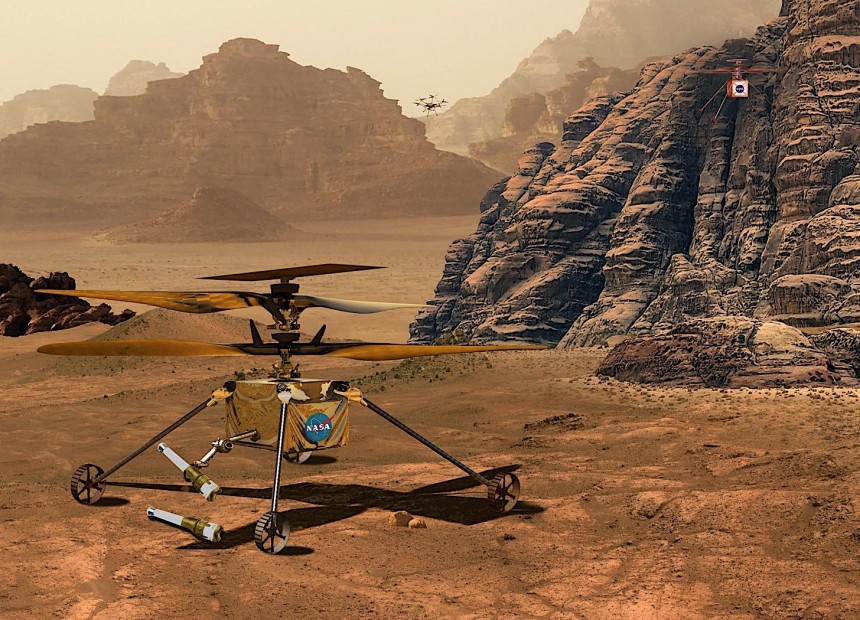As NASA was gearing up to send the Perseverance to Mars, I was expecting the rover to be the main topic of extra-planetary news once it reached its destination. Yet the honor somehow belongs to another piece of machinery that hitched a ride on the same mission.
NASA calls it the Ingenuity Mars Helicopter, and it arrived in the Jezero crater of the Red Planet in 2021, together with the Perseverance rover. The helicopter's mission was to prove that sustained, powered, and controlled flight is possible in the atmosphere of an alien world, even one as thin as that on Mars.
Now, when I say helicopter don’t go thinking I mean aircraft the likes of the ones we have here on Earth. Sure, Ingenuity does have rotors and a body, but it kind of looks more like a toy drone you can get off your local supermarket's shelf.
The things weighs here on Earth only four pounds (1.8 kg), and its body is a small box that contains the hardware it needs to do its job: computers, navigation sensors, and two cameras to snap both color and black-and-white images of Mars.
Four landing legs spring out from below the body, while on top of it a set of counter-rotating blades spin at 2,400 rpm to give the helicopter lift and forward motion. In all, the thing is 19 inches (0.5 meters) high, and the span of the rotors sits at 4 feet (1.2 meters).
The initial mission of the Ingenuity was supposed to last for just 30 days, during which a total of five experimental flights were planned. But, just like many other pieces of NASA hardware made before it, the helicopter long outlasted its designed mission and lifetime.
At the time of writing, the aircraft can show some stunning numbers. It flew no less than 72 times. It was in operation for about 1,000 Martian days (almost three Earth years, more than 33 times longer than originally planned) and covered a total distance of 10.5 miles (17.0 km), 14 times farther than planned.
The thing took off and landed from and on 48 different locations on Mars, clocking a total of 128.8 flying minutes – more than two hours in the skies of an alien world.
And the helo also evolved while up there. From its initial mission of proving a point it was promoted to the role of aerial scout for the Perseverance rover. It was remotely gifted with the ability to choose landing sites on its own, and the capability to clean itself after surviving one of those epic Martian sand storms.
Ingenuity's time on Mars was not without problems. It was faced at one point with a dead sensor, and it had to perform emergency landings three times. It even survived a Martian winter.
This one was particularly tricky to navigate, as the helicopter's heaters did not work for some reason, so the flight computer froze and reset periodically, posing quite a challenge for controllers here on Earth.
With all of the above in mind you'd think the Ingenuity proved itself unbreakable. You'd be wrong, as it now lies hurt on the surface of Mars, unable to ever fly again.
On January 18 Ingenuity was to perform a short vertical flight. This was meant to allow NASA teams to determine its location after it performed an emergency landing during the previous flight.
The helo took off as planned, reached an altitude of 40 feet (12 meters), and hovered there for 4.5 seconds. It then started its descent, and this is where things went wrong.
As per NASA, at a time when Ingenuity was 3 feet (1 meter) above the surface, it lost contact with the Perseverance. The rover acts as a communications relay between Earth and the helicopter, and not being able to reach it proved catastrophic.
It was only on January 19 that NASA managed to reestablish comms with the Ingenuity, and started retrieving images captured during the flight. It would appear one of the rotor blades of the aircraft was damaged during the flight, and it's serious enough to prevent it from ever taking off.
With that in mind, NASA's administrator Bill Nelson officially signed the death certificate for the Ingenuity helicopter (you can see that in the video attached below this text).
NASA says the cause of the comms dropout is still under investigation. At the time of writing the helicopter rests in an upright position on the surface of the planet, and it is in contact with the NASA team. Efforts to download the remaining images and the Ingenuity memory are being made.
Even though the mission is now officially over, the insight gained with the helicopter is priceless for future planetary exploration missions. Already NASA is considering using helicopters as part of the Mars Sample Return mission, but it is also working on some that could be sent as far out as Titan.
Now, when I say helicopter don’t go thinking I mean aircraft the likes of the ones we have here on Earth. Sure, Ingenuity does have rotors and a body, but it kind of looks more like a toy drone you can get off your local supermarket's shelf.
The things weighs here on Earth only four pounds (1.8 kg), and its body is a small box that contains the hardware it needs to do its job: computers, navigation sensors, and two cameras to snap both color and black-and-white images of Mars.
Four landing legs spring out from below the body, while on top of it a set of counter-rotating blades spin at 2,400 rpm to give the helicopter lift and forward motion. In all, the thing is 19 inches (0.5 meters) high, and the span of the rotors sits at 4 feet (1.2 meters).
The initial mission of the Ingenuity was supposed to last for just 30 days, during which a total of five experimental flights were planned. But, just like many other pieces of NASA hardware made before it, the helicopter long outlasted its designed mission and lifetime.
At the time of writing, the aircraft can show some stunning numbers. It flew no less than 72 times. It was in operation for about 1,000 Martian days (almost three Earth years, more than 33 times longer than originally planned) and covered a total distance of 10.5 miles (17.0 km), 14 times farther than planned.
And the helo also evolved while up there. From its initial mission of proving a point it was promoted to the role of aerial scout for the Perseverance rover. It was remotely gifted with the ability to choose landing sites on its own, and the capability to clean itself after surviving one of those epic Martian sand storms.
Ingenuity's time on Mars was not without problems. It was faced at one point with a dead sensor, and it had to perform emergency landings three times. It even survived a Martian winter.
This one was particularly tricky to navigate, as the helicopter's heaters did not work for some reason, so the flight computer froze and reset periodically, posing quite a challenge for controllers here on Earth.
With all of the above in mind you'd think the Ingenuity proved itself unbreakable. You'd be wrong, as it now lies hurt on the surface of Mars, unable to ever fly again.
On January 18 Ingenuity was to perform a short vertical flight. This was meant to allow NASA teams to determine its location after it performed an emergency landing during the previous flight.
As per NASA, at a time when Ingenuity was 3 feet (1 meter) above the surface, it lost contact with the Perseverance. The rover acts as a communications relay between Earth and the helicopter, and not being able to reach it proved catastrophic.
It was only on January 19 that NASA managed to reestablish comms with the Ingenuity, and started retrieving images captured during the flight. It would appear one of the rotor blades of the aircraft was damaged during the flight, and it's serious enough to prevent it from ever taking off.
With that in mind, NASA's administrator Bill Nelson officially signed the death certificate for the Ingenuity helicopter (you can see that in the video attached below this text).
NASA says the cause of the comms dropout is still under investigation. At the time of writing the helicopter rests in an upright position on the surface of the planet, and it is in contact with the NASA team. Efforts to download the remaining images and the Ingenuity memory are being made.
Even though the mission is now officially over, the insight gained with the helicopter is priceless for future planetary exploration missions. Already NASA is considering using helicopters as part of the Mars Sample Return mission, but it is also working on some that could be sent as far out as Titan.










